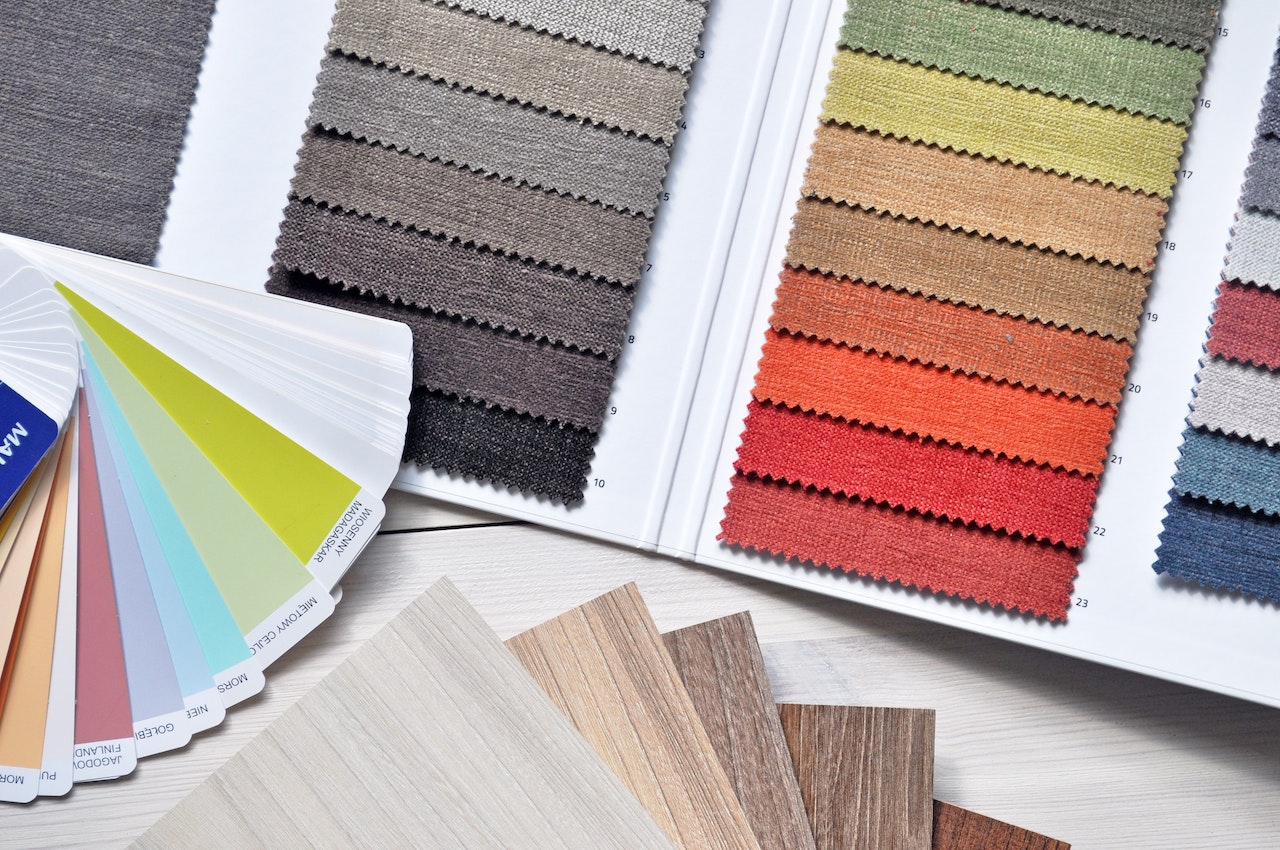Investing in Your Venue: Choosing Flooring and Seating Materials That Will Last
A crucial aspect of designing a successful venue is choosing the best restaurant flooring and seating materials. Fortunately, as a leading hospitality consultant in San Diego, RMD Group has deep experience with various flooring and seating options, and we’re here to help our clients make an informed decision that meets their needs and budget.
Flooring That Fits: Choosing the Best Flooring Option for Your Restaurant, Bar, Hotel, or Nightclub
We have worked with various clients in the hospitality industry, ranging from pizzerias to top hotel brands. Through this extensive experience, we’ve gained valuable insights on the essential steps, best practices, and potential challenges involved in opening or renovating a restaurant or bar.
Based on those experiences, here’s a suggestion:
If you want to design a money-making hospitality venue, choose your flooring and seating materials wisely, as your interior design choices can make or break your business.
Key Considerations for Choosing Seating and Flooring Materials for Your Restaurant
When designing or renovating your restaurant or bar, choosing the right flooring and seating materials is essential to creating a comfortable and safe environment for your customers. The materials you choose should be both practical and aesthetically pleasing while also meeting the needs of your business.
Considerations to keep in mind:
1. Consider a Damage Resistant Surface Built for Heavy Use
Choose a flooring material that can endure the daily wear and tear caused by high foot traffic, spills, and constant movement of chairs.
Avoid a dingy and dated-looking dining room by choosing a floor that doesn’t dent easily as people are likely to drop things on it or damage it with high-heels, this is especially important for nightclub floors.
2. Check for a Commercial Warranty
Before buying your restaurant flooring, make sure to verify that the company provides a commercial warranty to avoid unforeseen expenses down the line.
3. Opt for Slip-Resistant Flooring
Prevent slips and falls in your restaurant by selecting flooring that is slip-resistant–steer clear of glossy, ultra-smooth surfaces!
4. Prioritize Waterproof Flooring
Spills are inevitable in a restaurant. It’s crucial to select a floor that can withstand moisture to avoid having to replace it frequently.
5. Seek Easy-to-Clean Flooring
Opt for a flooring material that requires minimal effort to clean and sanitize, given the daily cleaning and maintenance requirements.
6. Find the Right Color
Aesthetics matter. Select a brand that offers a range of color options that will match your restaurant or nightclubs design.
Top Flooring Materials for Bars & Restaurants: Advantages and Disadvantages
In terms of flooring, there are many options available. Hardwood, cork, vinyl, cement, and carpet are some of the popular ones. While flooring can make a huge difference in aesthetics in our homes, in businesses, it needs to be durable above all else.
When choosing your flooring material, cost, safety, durability, and look are essential. Let’s go over some popular flooring options for restaurants and nightclubs to learn more about their advantages and disadvantages.
Carpet

When considering the ideal flooring material for your venue, carpet probably isn’t the first thing that comes to mind for restaurant owners. However, commercial-grade carpet that offers high-traction, noise absorption, and solid durability is one of our favorite options for restaurants, hotels, and event spaces.
Pros:
- Adds warmth
- Cost effective
- Short lead times
- Wide range of colors and textures available
- Great for acoustics
Cons:
- Traps odors
- Stains more easily than other options
- Shows wear and tear
- Looks dated quickly
It’s worth noting that regular cleaning and maintenance can help mitigate odor issues. You can also install in tiles so it’s easy to replace untreatable stains and damaged areas. Carpeting can also be a suitable option for those looking for a softer, quieter, and more comfortable flooring option in their restaurant.
That being said, we don’t recommend it in bars or nightclubs.
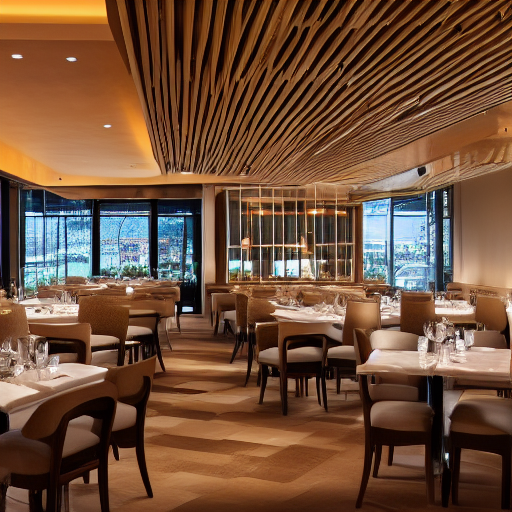
Cork
Cork flooring is a great option for hospitality venues that prioritize natural elements in their design. Cork that’s harvested from living cork oak trees is a renewable resource that is easy to maintain and comes at a relatively low cost. Additionally, cork flooring offers a soft, cushioned surface that can reduce noise and serve as a good insulator.
Cork floors are hypoallergenic, anti-microbial, and ecologically friendly, providing a more natural look to the restaurant. However, cork floors can be easily damaged by furniture, sharp objects, and foot traffic, and are susceptible to water damage that can cause warping and discoloration. They also tend to fade in sunlight and require regular sealing to protect against water stains and damage.
Pros
- Made from a renewable resource
- Relatively inexpensive
- Easy to install and maintain
- Soft and cushioned surface
- Hypoallergenic and anti-microbial
- Can be refinished rather than replaced
- Provides a natural look
Cons:
- Susceptible to damage from furniture, sharp objects, and foot traffic
- Susceptible to water damage
- Can fade in sunlight
- Requires regular sealing to protect against water stains and damage
- May need to be replaced or refinished more frequently than other types of floors
Cork flooring can be a great choice for hospitality venues due to its eco-friendliness, low cost, and comfort, but it’s important to be aware of its susceptibility to damage and water stains.
Vinyl Tile & Planks
Move over, linoleum, luxury vinyl tile or plank is a popular and cost-effective alternative with good reason. With newer technology, vinyl products have become sturdier and more dent-resistant. Plus, vinyl tile flooring is fully water-resistant and easy to clean and maintain.
However, luxury vinyl floors are still softer and weaker compared to other flooring options, which means they may be punctured, scuffed, or dented. Additionally, vinyl tile and plank may fade when exposed to UV light making it less suitable for use in restaurants with a lot of natural lighting.
Pros:
- Less expensive than many other flooring options
- Fully water-resistant
- Able to withstand heavy foot traffic
- Easy to clean and maintain
- Easy to install
- Many color ways and textures available
- Cost-effective option
Cons:
- Softer and weaker compared to other flooring options
- May be punctured or dented
- May fade when exposed to UV light
- Not very good for acoustics
Concrete
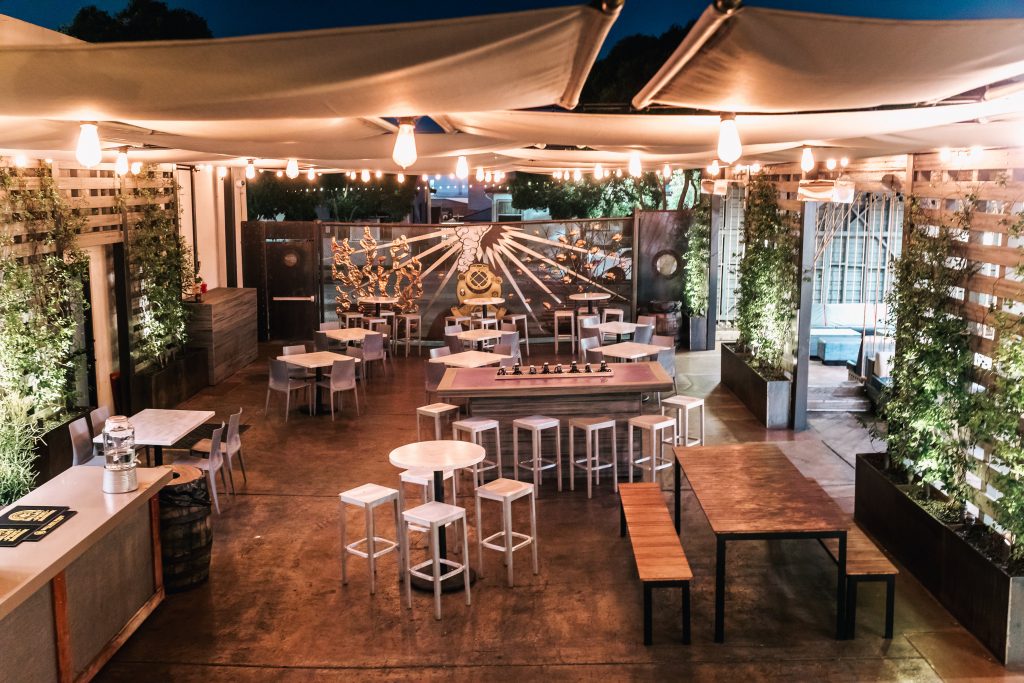
Concrete is a durable and cost-effective flooring option for bars and nightclubs with high foot traffic, that is easy to maintain and lasts for decades with proper installation and maintenance, and offers endless design options. However, it can be slippery when wet, uncomfortable to stand on for long periods of time, and loud, and its benefits depend on proper installation and maintenance.
Pros:
- Extremely durable and can withstand high foot traffic
- Cost-effective option, especially for large spaces
- Waterproof and easy to maintain
- Can simulate the look of pricier materials with different color and texture options
- Resistant to mold and mildew growth
Cons:
- Slippery when wet
- Uncomfortable to stand on for long periods of time
- Loud and can impact acoustics
- Benefits depend on proper installation and maintenance
Polished concrete floors are a cost-effective, durable, and easy to maintain option for bars and nightclubs. Just keep in mind that they can but can be slippery, uncomfortable to stand on for long periods of time, and loud.
Laminates & Engineered Wood Flooring

Laminate floors are a cost-effective option that mimic the look of real wood, and are easy to clean, but may chip and swell with exposure to water, and cannot be refinished.
Pros:
- Relatively inexpensive compared to hardwood floors
- Comes in a range of colors and mimics the look of real wood
- Easy to clean and scratch-resistant
- Durable
Cons:
- Top layer can chip, especially in high traffic areas
- Sensitive to moisture, can swell if exposed to water
- Cannot be refinished
- May show signs of wear over time
Sitting in Style: Choosing the Perfect Coverings for Your Restaurant Seating
When choosing materials for seating, it’s important to prioritize longevity and durability. Luxurious materials like leather may offer a rich appearance, but they may not hold up as well as more durable options like vinyl. Additionally, materials like fabric may look great initially, but may quickly show signs of wear and tear.
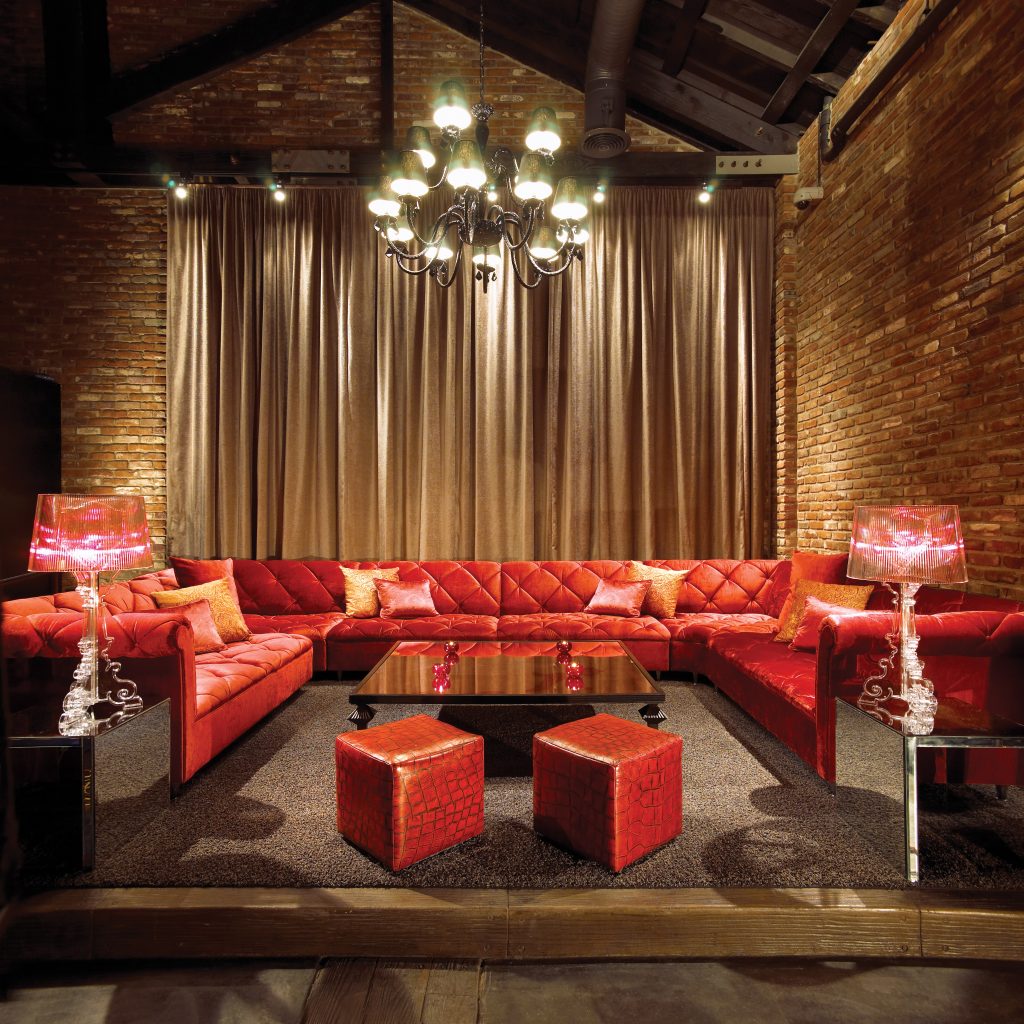
Ultimately, the goal should be to choose materials that will still look great after the first year of use.
On that note…
Here are some popular choices for upholstery for the seating in your restaurant, bar, or hotel.
Vinyl
Vinyl is a popular seating material for restaurants, as it offers a wide range of benefits at an affordable cost. Vinyl is made of synthetic materials, making it easy to clean and maintain, and it’s resistant to water and stains. Additionally, vinyl seating can be customized to fit any restaurant’s style, making it a versatile choice for any type of eatery.
Pros:
- Affordable and cost-effective option
- Resistant to water and stains, making it easy to clean and maintain
- Can be customized to fit any restaurant’s design aesthetic
- Durable and long-lasting
- Comfortable to sit on for long periods of time
Cons:
- Not as breathable as natural materials, which can make it uncomfortable during hot weather
- May not provide the same level of luxury as leather seating
- Can be prone to cracking over time if not properly maintained
- May not be as eco-friendly as other seating materials.
Vinyl seating is an affordable and durable option for restaurants, but it may not offer the same level of luxury as leather seating, and it’s not as eco-friendly as other seating materials. Nonetheless, it’s a popular choice for its affordability, versatility, and easy maintenance.
Leather
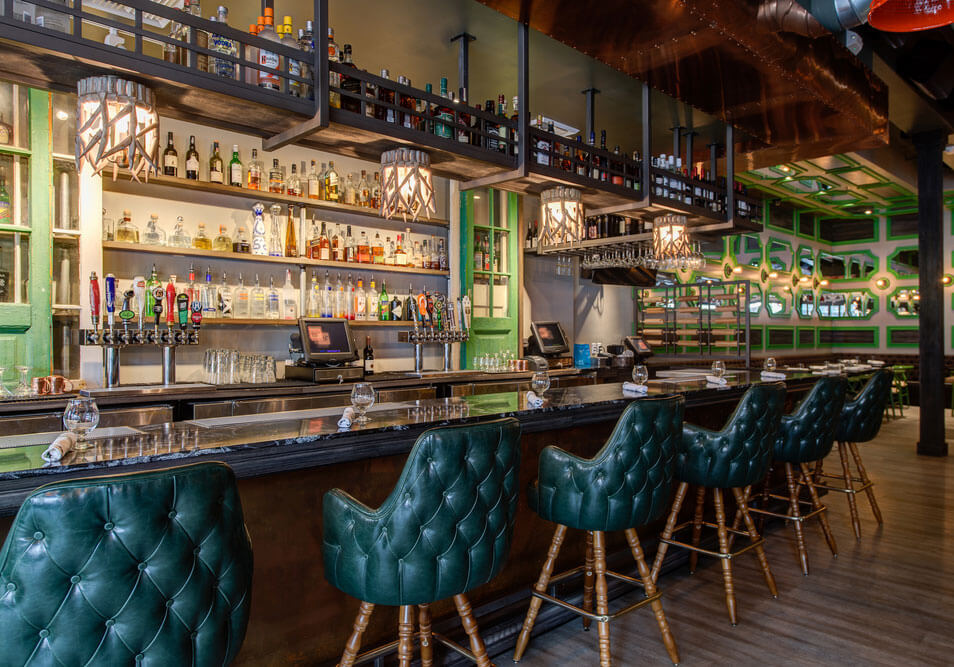
Leather seating is a luxurious option that can add a sophisticated touch to any restaurant’s or hotel’s ambiance. Leather seating is made of natural materials, which means it’s breathable and comfortable to sit on for long periods of time. It’s also incredibly durable and can withstand regular use, making it a worthwhile investment for restaurants.
Pros:
- Luxurious and sophisticated option that adds a touch of elegance to any restaurant’s ambiance
- Breathable and comfortable to sit on for long periods of time
- Durable and long-lasting
- Can be cleaned and maintained with relative ease
- Gets better with age and can develop a rich patina over time
Cons:
- Can be an expensive option compared to other materials
- May not be as resistant to stains and spills as vinyl or fabric seating
- Not as eco-friendly as other materials, especially if sourced from non-sustainable sources
- Requires regular maintenance and conditioning to maintain its quality and appearance.
Leather seating is a luxurious and durable option for restaurants that can add sophistication to the overall ambiance. However, it can be expensive and requires regular maintenance to keep it in top condition. Nonetheless, leather seating is a popular choice for its comfort, durability, and classic look.
Fabric
Fabric seating is a popular seat covering choice for restaurants looking for a comfortable and stylish option that can be customized to fit any design aesthetic.
With fabric seating, hospitality venues can choose from a wide range of materials, colors, and patterns to create a look that complements their overall décor. Additionally, fabric seating is typically less expensive than leather seating, making it a more affordable option.
Pros:
- Comfortable and soft to sit on, providing a cozy atmosphere
- Wide range of materials, colors, and patterns to choose from, offering endless customization options
- Less expensive than leather seating
- Can be cleaned and maintained with relative ease
- Offers a welcoming and inviting ambiance
Cons:
- May not be as durable as leather seating
- May not be as resistant to stains and spills as vinyl or leather seating
- Can be prone to fading or discoloration over time
- May not be as breathable as natural materials, which can make it uncomfortable during hot weather.
Fabric seating is a comfortable and customizable option for restaurants that want to create a welcoming and inviting ambiance. Although it may not be as durable as leather seating, it offers a wide range of customization options at a lower cost. To get the most out of your upholstery, look for a rub count of 30,000 – 50,000+ and avoid fabrics that dyed clothing, like jeans, can easily stain or rub off on.
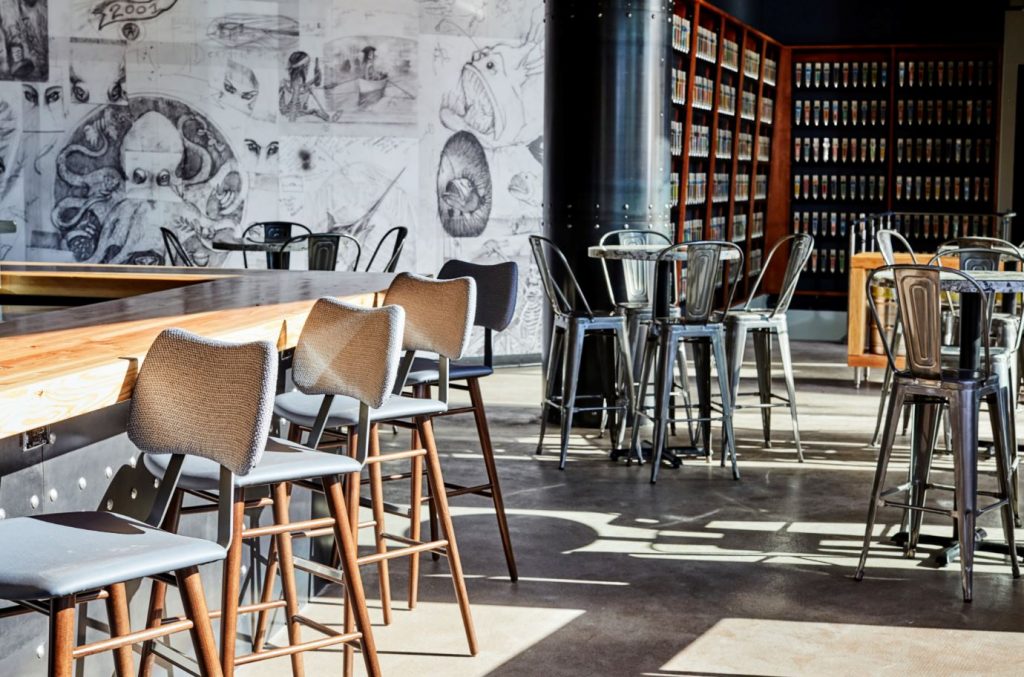
Metal
Metal seating is a durable and stylish option for restaurants that want to create an industrial or modern ambiance. Metal seating is typically made of steel or aluminum, making it sturdy and long-lasting. Additionally, metal seating is easy to clean and maintain, making it a practical option for restaurants with high foot traffic.
Pros:
- Durable and long-lasting option
- Stylish and modern, adding an industrial touch to any restaurant’s ambiance
- Easy to clean and maintain
- Can be used indoors or outdoors
- Lightweight and stackable for easy storage
Cons:
- May not be as comfortable as other seating materials, especially if not properly cushioned
- Can be prone to rust if not properly treated or coated
- May not be as customizable as other seating materials
- Can be noisy if not properly padded or cushioned
Although it may not be as comfortable as other seating materials, metal seating is a practical option that’s easy to clean and maintain. However, proper cushioning or padding is necessary to ensure comfort and prevent noise.
Maximizing Your Restaurant or Hotel’s Aesthetics and Functionality with the Right Materials
Choosing the right flooring and seating materials is crucial to the success of any hospitality venue. A visually appealing space that fits the vibe and personalities of your brand is great, but the form must follow function.
Our advice:
When choosing materials for flooring or seating, pick one based on your venue’s design and your guests’ needs, but don’t overspend on fancy flooring materials for your restaurant or bar that won’t last.
If you’re unsure of what materials would work best for your space, it’s always a good idea to consult with an experienced hospitality consultant or interior designer who can guide you in making informed decisions. Remember, your flooring and seating materials are not just design choices, but important investments in the success of your business.
an


